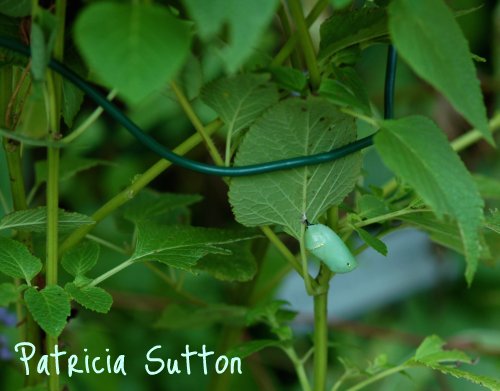 |
| Tiger Swallowtail nectaring on Purple Coneflower |
The typical garden may be “neat as a pin” but, to some, “ugly as sin” and pretty darned unfriendly to wildlife. I’m not saying that a garden has to be untidy, but so many of our maintenance tasks are just plain fussy and have the potential to be highly detrimental to the very critters we’ve invited into the garden. The ultimate maintenance task that really irks me, is when pond owners feel compelled to clean out their pond for winter. What are they thinking? Does anyone clean out a pond in the wild? Are there little woodland elves in green berets that scamper about the woods, raking leaves and pond gunk out of the bottom and literally scrubbing the sides of a natural pond? If so, I’ve never seen one! And thank goodness. Such tasks would eliminate next year’s dragonflies. Why? Because their nymphs survive the winter safely in the muck at the bottom of a pond. Frogs too sleep (hibernate) safely in the gunk at the bottom of a pond, below where the water freezes.
So, before grabbing pencil and paper to complete one more “to do” list for your garden, stop and ask yourself: (1) Is this truly necessary? (2) In a wild area like this (a pond, meadow, etc.) is there any way this would be done naturally? (3) Could this task harm wildlife in any way? So many garden tasks are driven by attempts to achieve a certain “look” in the garden and often at the expense of the very wildlife a gardener has gone to great lengths to attract.
 |
| Tall Sunflowers and New England Asters laid down by Hurricane Irene |
Hurricane Irene (August 28, 2011) flattened our wildlife garden here
in Cape May County, New Jersey, while we were away on vacation. But,
guess what? Despite the garden literally laying down due to strong
winds and heavy rain, we came home to find it still blooming strong and
still full of butterflies, bossy and hungry hummingbirds, Garden
Spiders, wasps, bees, Soldier Beetles . . . These garden visitors not
only didn’t mind the chaos Hurricane Irene had dealt, they didn’t seem
to notice.
 |
| Hidden Monarch chrysalis that miraculously survived my tidying up |
The group came and strolled through, and the first thing they found was a Monarch chrysalis less than one inch from one of my newly placed plant supports. How I hadn’t fatally damaged the chrysalis was beyond me. I hope that my tidy-up efforts didn’t harm any others, but I’ll bet they did.
 |
| American Goldfinch feeding on Purple Coneflower seed heads |
I stopped deadheading Purple Coneflower, Anise Hyssop, Black-eyed Susan, and Tall Sunflower years ago when I noticed American Goldfinch feasting on their spent seed heads all summer and fall.
I leave the garden standing in the fall and savor it all winter long. Birds benefit from the cover and spend lots of time in the winter garden finding both seeds and insects in the still-standing stalks.

I can’t imagine preferring a tidy, bare area to this bounty.
Next year’s butterflies are in the winter garden as eggs, partially grown caterpillars in curled up leaves, or as chrysalises attached to still-standing perennial stalks. Heaven forbid I should cut all that down in the fall and send it off to a compost pile or the dump. That would be like sending next year’s butterflies away forever.
 |
| Luna Moth |
© 2011, Pat Sutton.
All rights reserved. This article is the property of Native Plants and Wildlife Gardens. We have received many requests to reprint our work.
Our policy is that you are free to use a short excerpt which must give
proper credit to the author, and must include a link back to the
original post on our site. Please use the contact form above if you have
any questions.





